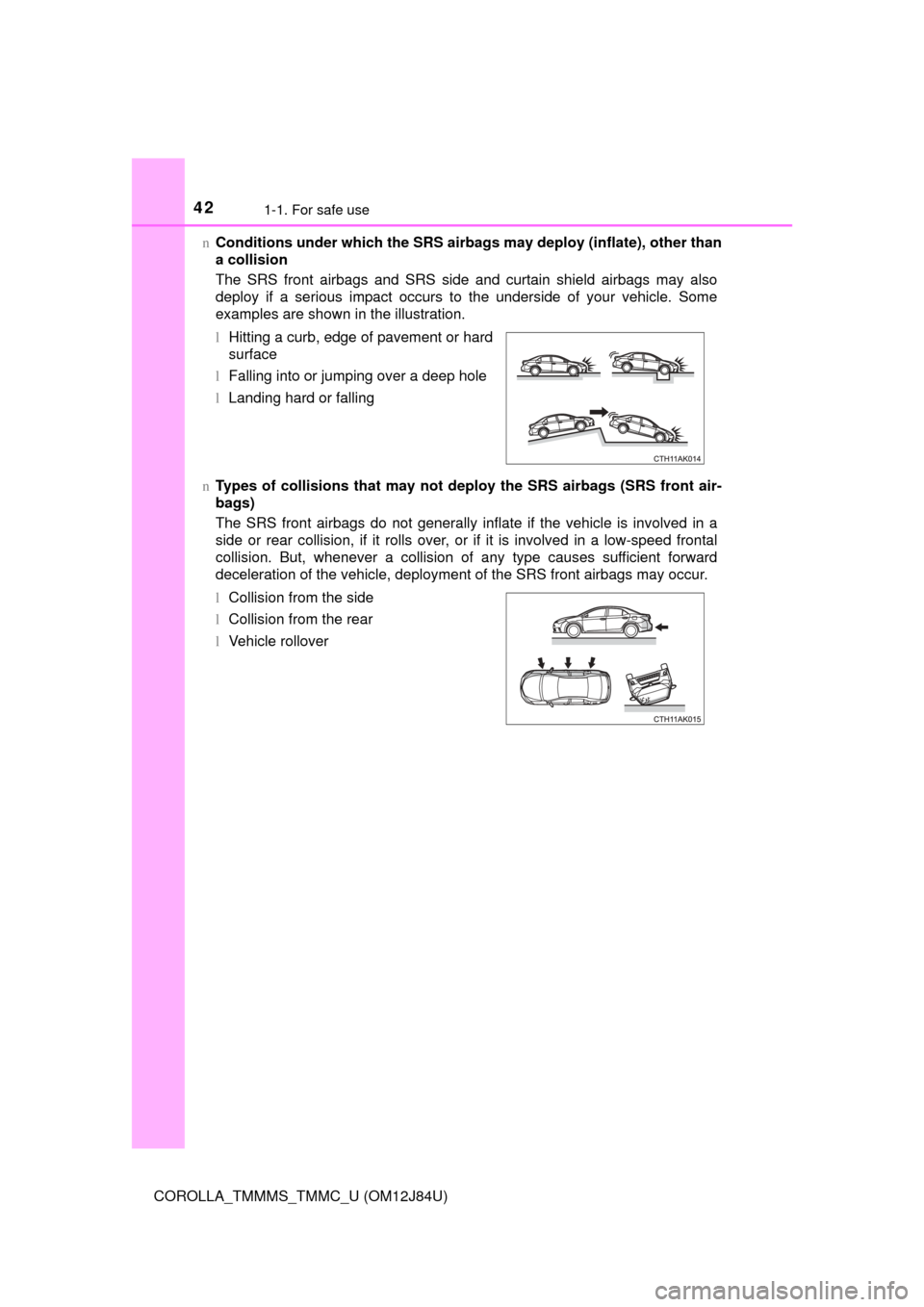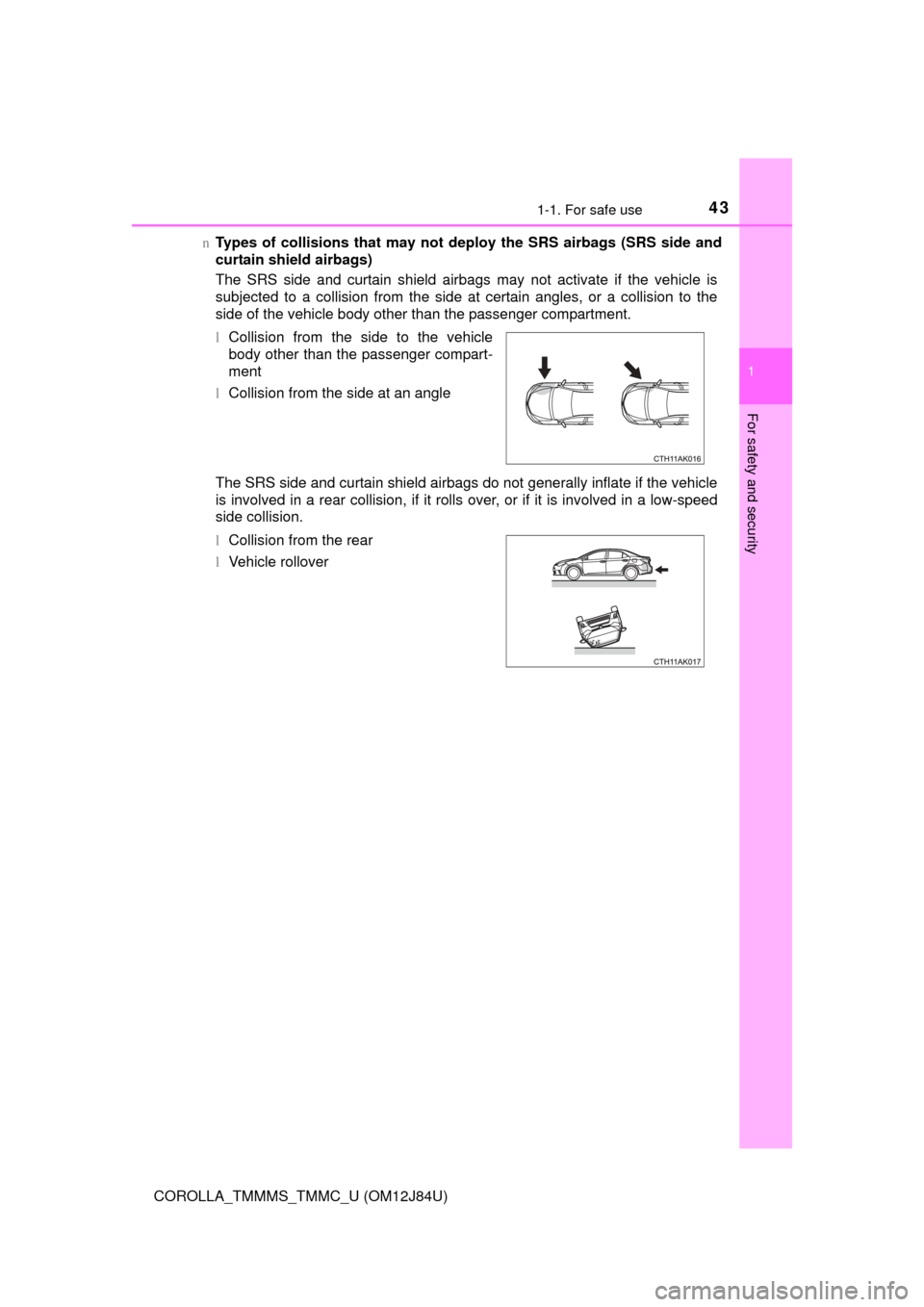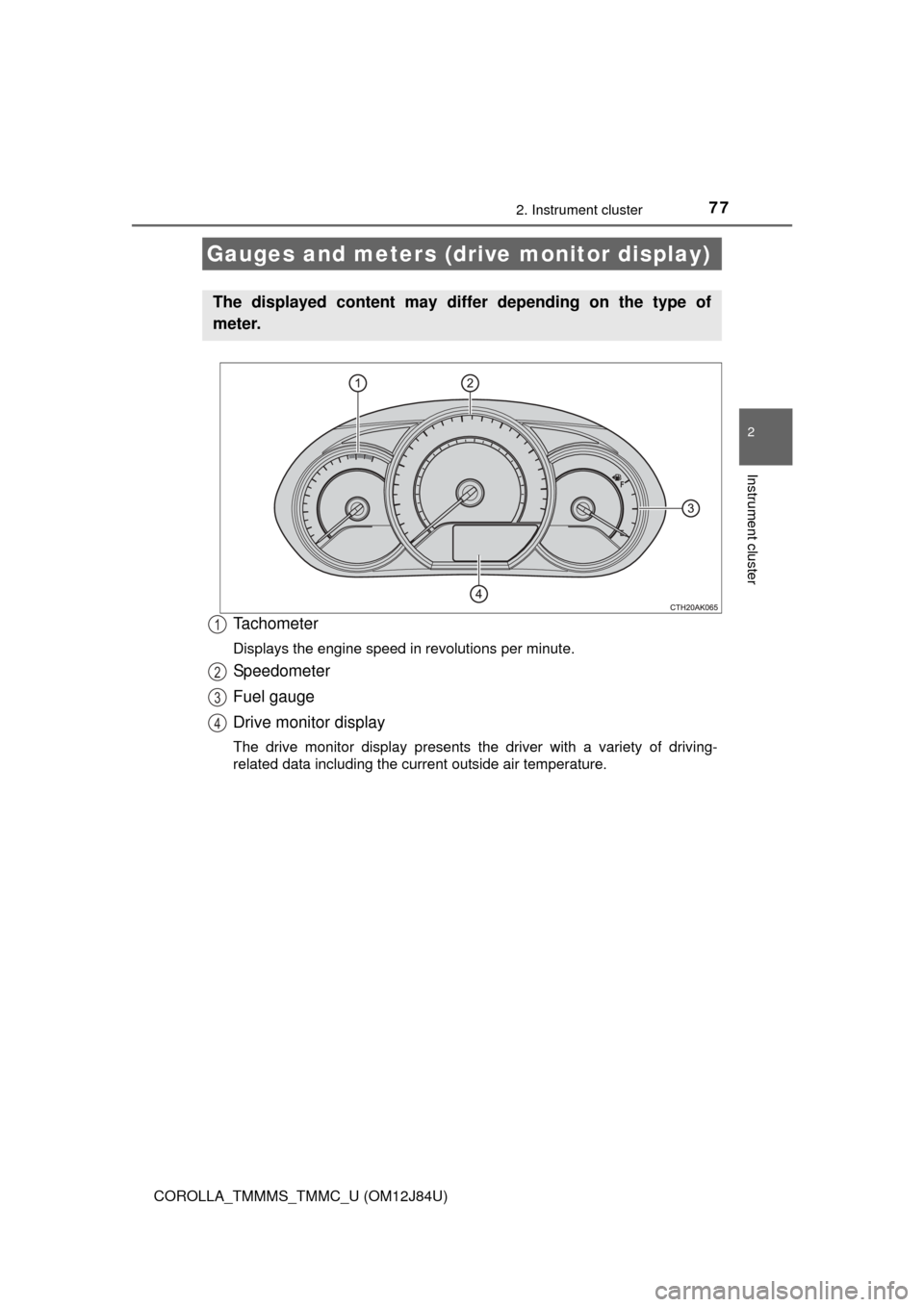2016 TOYOTA COROLLA Speed
[x] Cancel search: SpeedPage 9 of 620

9
COROLLA_TMMMS_TMMC_U (OM12J84U)The installation of a mobile two-way radio system in your vehicle could affect
electronic systems such as:
l
Multiport fuel injection system/sequential multiport fuel injection system
l Cruise control system (if equipped)
l Anti-lock brake system
l SRS airbag system
l Seat belt pretensioner system
Be sure to check with your Toyota dealer for precautionary measures or spe-
cial instructions regarding installation of a mobile two-way radio system.
Your Toyota is equipped with several sophisticated computers that will record
certain data, such as: • Engine speed
• Accelerator status
• Brake status
• Vehicle speed
• Shift position (except vehicles with a manual transmission)
The recorded data varies according to the vehicle grade level and options
with which it is equipped. Furthermore, these computers do not record con-
versations, sounds or pictures.
lData usage
Toyota may use the data recorded in these computers to diagnose malfunc-
tions, conduct research and development, and improve quality.
Toyota will not disclose the recorded data to a third party except:
• With the consent of the vehicle owner or with the consent of the lessee if the vehicle is leased
• In response to an official request by the police, a court of law or a govern- ment agency
• For use by Toyota in a law suit
• For research purposes where the data is not tied to a specific vehicle or vehicle owner
Installation of a mobile two-way radio system
Vehicle data recordings
Page 25 of 620

251-1. For safe use
1
For safety and security
COROLLA_TMMMS_TMMC_U (OM12J84U)
CAUTION
Observe the following precautions.
Failure to do so may cause the driver’s floor mat to slip, possibly interfering
with the pedals while driving. An unexpectedly high speed may result or it may
become difficult to stop the vehicle. This could lead to an accident, resulting in
death or serious injury.
nWhen installing the driver’s floor mat
lDo not use floor mats designed for other models or different model year
vehicles, even if they are Toyota Genuine floor mats.
l Only use floor mats designed for the driver’s seat.
l Always install the floor mat securely using the retaining hooks (clips) pro-
vided.
l Do not use two or more floor mats on top of each other.
l Do not place the floor mat bottom-side up or upside-down.
n Before driving
lCheck that the floor mat is securely
fixed in the correct place with all the
provided retaining hooks (clips). Be
especially careful to perform this check
after cleaning the floor.
l With the engine stopped and the shift
lever in P (automatic transmission or
continuously variable transmission) or N
(manual transmission), fully depress
each pedal to the floor to make sure it
does not interfere with the floor mat.
Page 41 of 620

411-1. For safe use
1
For safety and security
COROLLA_TMMMS_TMMC_U (OM12J84U)
nIf the SRS airbags deploy (inflate)
lBruising and slight abrasions may result from contact with a deploying
(inflating) SRS airbag.
l A loud noise and white powder will be emitted.
l Parts of the airbag module (steering wheel hub, airbag cover and inflator) as
well as the front seats, parts of the front and rear pillars, and roof side rails,
may be hot for several minutes. The airbag itself may also be hot.
l The windshield may crack.
n SRS airbag deployment conditions (SRS front airbags)
lThe SRS front airbags will deploy in the event of an impact that exceeds the
set threshold level (the level of force corresponding to an approximately 12 -
18 mph [20 - 30 km/h] frontal collision wi th a fixed wall that does not move or
deform).
However, this threshold velocity will be considerably higher in the following
situations:
• If the vehicle strikes an object, such as a parked vehicle or sign pole, which can move or deform on impact
• If the vehicle is involved in an underride collision, such as a collision in
which the front of the vehicle “underrides”, or goes under, the bed of a
truck
l Depending on the type of collision, it is possible that only the seat belt pre-
tensioners will activate.
l The SRS front airbags for the front pass enger will not activate if there is no
passenger sitting in the front passenger seat. However, the SRS front air-
bags for the front passenger may deploy if luggage is put in the seat, even if
the seat is unoccupied.
l The SRS seat cushion airbag on the front seats will not operate if the occu-
pant is not wearing a seat belt.
n SRS airbag deployment conditions (SRS side and curtain shield airbags)
l The SRS side and curtain shield airbags will deploy in the event of an
impact that exceeds the set threshold level (the level of force corresponding
to the impact force produced by an approximately 3300 lb. [1500 kg] vehicle
colliding with the vehicle cabin from a direction perpendicular to the vehicle
orientation at an approximate speed of 12 - 18 mph [20 - 30 km/h]).
l The SRS side and curtain shield airbags may also deploy in the event of a
severe frontal collision.
Page 42 of 620

421-1. For safe use
COROLLA_TMMMS_TMMC_U (OM12J84U)n
Conditions under which the SRS airbags may deploy (inflate), other than
a collision
The SRS front airbags and SRS side and curtain shield airbags may also
deploy if a serious impact occurs to the underside of your vehicle. Some
examples are shown in the illustration.
n Types of collisions that may not de ploy the SRS airbags (SRS front air-
bags)
The SRS front airbags do not generally inflate if the vehicle is involved in a
side or rear collision, if it rolls over, or if it is involved in a low-speed frontal
collision. But, whenever a collision of any type causes sufficient forward
deceleration of the vehicle, deployment of the SRS front airbags may occur. l Hitting a curb, edge of pavement or hard
surface
l Falling into or jumping over a deep hole
l Landing hard or falling
l Collision from the side
l Collision from the rear
l Vehicle rollover
Page 43 of 620

431-1. For safe use
1
For safety and security
COROLLA_TMMMS_TMMC_U (OM12J84U)n
Types of collisions that may not de ploy the SRS airbags (SRS side and
curtain shield airbags)
The SRS side and curtain shield airbags may not activate if the vehicle is
subjected to a collision from the side at certain angles, or a collision to the
side of the vehicle body other than the passenger compartment.
The SRS side and curtain shield airbags do not generally inflate if the vehicle
is involved in a rear collision, if it rolls over, or if it is involved in a low-speed
side collision. l Collision from the side to the vehicle
body other than the passenger compart-
ment
l Collision from the side at an angle
l Collision from the rear
l Vehicle rollover
Page 55 of 620

551-1. For safe use
1
For safety and security
COROLLA_TMMMS_TMMC_U (OM12J84U)
CAUTION
nChild restraint precautions
lFor effective protection in automobile accidents and sudden stops, a child
must be properly restrained, using a seat belt or child restraint system
depending on the age and size of the child. Holding a child in your arms is
not a substitute for a child restraint system. In an accident, the child can be
crushed against the windshield, or between you and the vehicle’s interior.
l Toyota strongly urges the use of a proper child restraint system that con-
forms to the size of the child, installed on the rear seat. According to acci-
dent statistics, the child is safer when properly restrained in the rear seat
than in the front seat.
l Never install a rear-facing child restraint system on the front passenger
seat even if the “AIR BAG OFF” indicator light is illuminated. In the event
of an accident, the force of the rapid inflation of the front passenger airbag
can cause death or serious injury to the child if the rear-facing child
restraint system is installed on the front passenger seat.
l A forward-facing child restraint system may be installed on the front pas-
senger seat only when it is unavoidable. A child restraint system that
requires a top tether strap should not be used in the front passenger seat
since there is no top tether strap anchor for the front passenger seat.
Adjust the seatback as upright as possible and always move the seat as
far back as possible even if the “AIR BAG OFF” indicator light is illumi-
nated, because the front passenger airbag could inflate with considerable
speed and force. Otherwise, the child may be killed or seriously injured.
l Do not use the seat belt extender when installing a child restraint system
on the front or rear passenger seat. If installing a child restraint system
with the seat belt extender connected to the seat belt, the seat belt will not
securely hold the child restraint system, which could cause death or seri-
ous injury to the child or other passengers in the event of a sudden stop,
sudden swerve or accident.
l Do not allow the child to lean his/her head or any part of his/her body
against the door or the area of the seat, front and rear pillars or roof side
rails from which the SRS side airbags or SRS curtain shield airbags deploy
even if the child is seated in the child restraint system. It is dangerous if
the SRS side airbags and curtain shield airbags inflate, and the impact
could cause death or serious injury to the child.
l Make sure you have complied with all installation instructions provided by
the child restraint manufacturer and that the system is properly secured. If
it is not secured properly, it may cause death or serious injury to the child
in the event of a sudden stop or accident.
Page 77 of 620

772. Instrument cluster
2
Instrument cluster
COROLLA_TMMMS_TMMC_U (OM12J84U)
Tachometer
Displays the engine speed in revolutions per minute.
Speedometer
Fuel gauge
Drive monitor display
The drive monitor display presents the driver with a variety of driving-
related data including the current outside air temperature.
Gauges and meters (drive monitor display)
The displayed content may differ depending on the type of
meter.
1
2
3
4
Page 80 of 620

802. Instrument cluster
COROLLA_TMMMS_TMMC_U (OM12J84U)n
Driving range
Displays the estimated maximum distance that can be driven with
the quantity of fuel remaining.
• This distance is computed based on your average fuel consumption. As
a result, the actual distance that can be driven may differ from that dis-
played.
• When only a small amount of fuel is added to the tank, the display may
not be updated.
When refueling, turn the engine switch off. If the vehicle is refueled with-
out turning the engine switch off, the display may not be updated.
n
Average vehicle speed
Displays the average vehicle speed since the engine was last
started.
*: Press and hold the “DISP” switch to reset.
Eco Driving Indicator Light can be
activated or deactivated.
While the odometer is being
displayed, press and hold the
“DISP” switch to display the
Eco Driving Indicator Light cus-
tomization screen.
Press the “DISP” switch to set
Eco Driving Indicator Light to on
or off.
Press and hold the “DISP”
switch to complete the setting.
Eco Driving Indicator Light cu stomization (except vehicles with
a manual transmission)
1
2
3